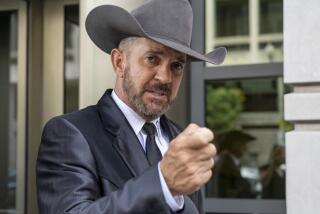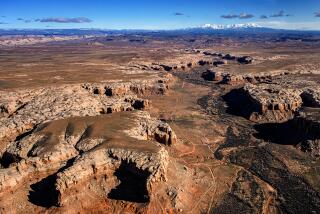Op-Ed: Pushing the BLM out of Washington puts our public lands in peril

County commissioners in the rural American West possess the daunting authority of Afghan warlords, it’s been said. They wield their power by demanding federal agencies do their bidding in the vast expanse of public lands in which the counties are embedded. Too often, they have their way.
Last week, the Trump administration announced a plan to move the Bureau of Land Management’s top officials out of Washington and into regional western offices. The scheme will only exaggerate the influence of county commissioners, to the detriment of most Americans.
Western counties are enormous. Utah’s largest county, San Juan, at nearly 8,000 square miles, is larger than Connecticut and almost as big as New Jersey. Like many counties in the rural West, San Juan is too dry and too remote for dense settlement; fewer than two people per square mile live there.
Under the Trump administration, local officials in dozens of such unpopulated counties have been flexing their muscles, especially in Utah. A telling photo taken at the Utah Capitol in December 2017 shows a beaming San Juan County Commissioner Bruce Adams with triumphant fist raised as President Trump eviscerates Bears Ears (within Adams’ southeastern Utah county) and Grand Staircase-Escalante national monuments and signs Adams’ Make San Juan County Great Again cowboy hat.
Trump’s drastic downsizing of Utah’s two big national monuments (reducing Bears Ears by 85%; Grand Staircase by half) grew out of fierce opposition to these designations from rural county commissioners who oppose even the concept of federal public lands. The Utah congressional delegation and the governor amplified their voices, and helped the president ignore nearly 3 million comments from citizens across the country who urged that the monuments remain intact.
Like most Utah elected officials, county commissioners tend to be more extreme politically than their constituents. The state’s culture almost guarantees the election of conservative Republican members of the Church of Jesus Christ of Latter-day Saints. The overwhelmingly white power structure shows little respect for Native nations concerned about the future of their sacred lands. “Official” Utah often scorns more liberal, urban Wasatch Front residents who value conservation over extraction. Groups such as the regional Escalante-Boulder Chamber of Commerce, whose members support the restoration of Grand Staircase, are marginalized.
This spring, Trump’s BLM took two actions in Utah supported by county commissioners and opposed by conservationists. They did so with little or no public discussion, skirting the law.
Utah’s Garfield and Wayne counties, settings for these imperious actions, each has less than 4% private land. Garfield is Utah’s most sparsely inhabited county, where 5,078 people live across 5,208 square miles. Neighboring Wayne is a close match, with 2,719 folks in 2,466 square miles. Together, they contain portions of three national parks, one national monument, two national forests and a national recreation area, enhancing the heritage of the 99.9998% of American citizens who don’t live there but share in their ownership.
With a largely closed-door process, the BLM granted Garfield County’s wish to pave a section of the Burr Trail, a scenic backway connecting Glen Canyon National Recreation Area with Grand Staircase-Escalante National Monument through Capitol Reef National Park. County officials, perhaps tipped off in advance, were poised to begin work the moment the final assessment was released. The public announcement came on a Monday; by Tuesday, the county had paved 2/3 of the road segment — before conservationists could sue.
For decades, backcountry enthusiasts and the National Park Service have fought to preserve this adventurous backcountry dirt road. The elected officials of Garfield County have strived just as hard to see the whole route paved.
A month after the Burr Trail decision, the BLM opened 5,400 acres of public land at Factory Butte in Wayne County to unlimited OHV, or off-highway vehicle use, again with little or no public discussion. This time, the announcement came on the Wednesday before Memorial Day, the busiest weekend of the year for “freeriders” to revel in a newly expanded play area.
Factory Butte, with its intricately sculpted skirt of gray badlands, symbolizes Utah wilderness in worldwide media. Dirt bikes and off-road vehicles leave scars that will not heal and stir up dust that plumes eastward into snowfields in the Colorado Rockies, accelerating spring snowmelt and complicating water management across the climate-change-stricken Colorado River Basin. For 13 years, off-road vehicles were banned in the area to protect wilderness and scenery, including fragile habitat for two federally listed endangered cactus species. The BLM had no reason to lift this ban other than the Wayne County commissioners’ receptivity to pressure from OHV groups.
The BLM knows these are controversial issues and places. Officials could easily predict the citizen outrage, bad press and litigation to come. But the Trump administration is directing the BLM to prioritize local input and access, which translates as deference to the privileged few and as a lack of procedural fairness.
Planting the BLM leadership in the heart of the West, according to Colorado Sen. Cory Gardner, means local people “will have greater say on public lands decisions that affect their community.” Gardner, alas, equates “local” with the pro-extraction, anti-conservation values that dominate county commissions.
In fact, BLM officials — stewards of lands belonging to the nation, not to states, counties or municipalities — are supposed to serve the interests of us all. Moving them closer to country commissioners bodes poorly for the future of America’s irreplaceable public lands.
Utah writer and conservation advocate Stephen Trimble’s most recent book is “The Capitol Reef Reader.”
More to Read
A cure for the common opinion
Get thought-provoking perspectives with our weekly newsletter.
You may occasionally receive promotional content from the Los Angeles Times.






